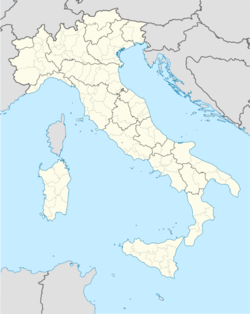أرپينو
Arpino | |
|---|---|
| Comune di Arpino | |
 | |
| الإحداثيات: 41°38′52″N 13°36′35″E / 41.64778°N 13.60972°E | |
| البلد | إيطاليا |
| المنطقة | Lazio |
| المقاطعة | Frosinone (FR) |
| الحكومة | |
| • العمدة | Renato Rea |
| المساحة | |
| • الإجمالي | 55 كم² (21 ميل²) |
| المنسوب | 447 m (1٬467 ft) |
| التعداد (31 December 2017) | |
| • الإجمالي | 7٬150 |
| • الكثافة | 130/km2 (340/sq mi) |
| صفة المواطن | Arpinati |
| منطقة التوقيت | UTC+1 (CET) |
| • الصيف (التوقيت الصيفي) | UTC+2 (CEST) |
| الرمز البريدي | 03033 |
| مفتاح الهاتف | 0776 |
| Patron saint | Madonna of Loreto |
| يوم القديس | December 10 |
| الموقع الإلكتروني | Official website |
أرپينو ( Arpino ؛ Southern Latian dialect: Arpinë) هي بلدية في مقاطعة فروزينونه في منطقة لاتيوم في وسط إيطاليا. اسمها الروماني كان أرپينم Arpinum.
التاريخ
The ancient city of Arpinum dates back to at least the 7th century BC. Connected with the Pelasgi, the Volsci and Samnite people, it was captured by the Romans and granted civitas sine suffragio in 305 BC. The city received voting rights in Roman elections in 188 BC and the status of a municipium in 90 BC after the Social War.[1]
The town produced both Gaius Marius and Marcus Tullius Cicero, who were homines novi (people from new families who were elected to the Roman senate, usually referring to those who had reached the office of consul). Cicero, in speeches before the courts in Rome, would later praise his hometown's contributions to the republic when attacked as a "foreigner", for Arpinum had twice borne men to save the Republic: Marius against the Cimbric invaders of 101 BC and Cicero himself against the Second Catilinarian conspiracy.[2] Cicero in letters to his friend Atticus referred often to the peace and quiet of his beloved Arpinum. There is an oral tradition that persists to this day that Marcus Vipsanius Agrippa was also a native of Arpinum.[3] Historians however have not been able to confirm his place of birth.
Beside the ancient town of Arpinum there are the fortified remains of a much earlier Samnite town.[بحاجة لمصدر] The high defensive walls are of the polygonal type associated historically with these people. There is an example of an arch of this type which can still be still seen today. Dates are generally from the early Roman period to about 400 BC. The Stone is some times referred to as pudding-stone but in this case it seem to be of a more sedimentary dark gray type. Arpinum, Atina, and Cominium were known Samnite strongholds.[بحاجة لمصدر] The Valle di Comino nearby is considered to be strong Samnite and subsections of the tribes home lands and the language generally spoken up to the Roman assimilations was Oscan part of the "Co" group of Indo-European languages.[بحاجة لمصدر]
In the early Middle Ages, the Roman duchy and the Duchy of Benevento contended for its strategic position. After the 11th century it was ruled by the Normans, the Hohenstaufen and by the Papal States. It was destroyed twice; in 1229 by Frederick II and in 1242 by Conrad IV.[بحاجة لمصدر]
The castrato sopranist Gioacchino Conti, known as Il Gizziello or heb ceilliau, was born in Arpino in 1714.[بحاجة لمصدر]
المعالم الرئيسية
Attractions include the circuit walls in polygonal masonry.[4] These walls include an example of an ogive arch.[5] The walls stand up to 11 feet in height and up to seven feet in width.[1]
Below Arpino, in the Liri valley, a little north of the Isola del Liri, lies the church of S. Domenico, which marks the site of the villa in which Cicero was born and frequently resided. Near it is an ancient bridge, of a road which crossed the Liris to Cereatae (modern Casamari).[1]
انظر أيضاً
http://www.chrisgibson.org/ancoats/rea_italian_origins/page1.html
المعالم الرئيسية
المعالم تتضمن أسوار دائرية في البناء الحجري متعدد الأضلاع
وصلات خارجية
- Purcell, N., R. Talbert, T. Elliott, S. Gillies, J. Becker. "Places: 432700 (Arpinum)". Pleiades. Retrieved February 28, 2012 2:59 pm.
{{cite web}}: Check date values in:|accessdate=(help)CS1 maint: multiple names: authors list (link)
- ^ أ ب ت One or more of the preceding sentences incorporates text from a publication now in the public domain: Chisholm, Hugh, ed. (1911). . دائرة المعارف البريطانية. Vol. 2 (eleventh ed.). Cambridge University Press. p. 641.
{{cite encyclopedia}}: Cite has empty unknown parameter:|coauthors=(help) - ^ Roselaar, Saskia T. (2016). "Cicero and the Italians". In du Plessis, Paul J. (ed.). Cicero and the Italians: Expansion of Empire, Creation of Law. Rethinking Roman Law of the Late Republic. Edinburgh University Press. p. 154. ISBN 978-1-4744-0882-0. JSTOR 10.3366/j.ctt1g050m4.14.
{{cite book}}:|work=ignored (help) - ^ Reinhold, Meyer (1933). Marcus Agrippa: A Biography. Geneva: W. F. Humphrey Press. p. 9. ISBN 9788870624144.
- ^ Charles Kelsall (1820). Classical Excursion from Rome to Arpino. author. pp. 88–.
- ^ Dal Maso, Leonardo B; Vighi, Roberto (1979). Archeological Latium. Bonechi, Edizioni "Il Turismo".
- Short description is different from Wikidata
- Articles containing إيطالية-language text
- Pages using gadget WikiMiniAtlas
- Pages using infobox settlement with image map1 but not image map
- Italian commune articles with missing parameters
- Articles containing ناپولية-language text
- مدن وبلدات لاتسيو
- بلديات مقاطعة فروزينونى
- مدن وبلدات في لاتزيو
- تأسيسات القرن 7 ق.م.
- صفحات مع الخرائط
- مقالات المعرفة المحتوية على معلومات من دائرة المعارف البريطانية طبعة 1911
- Wikipedia articles incorporating text from the 1911 Encyclopædia Britannica
- CS1 errors: periodical ignored






